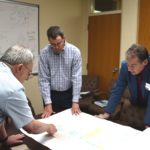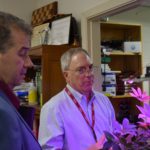Precision agriculture, nutrition discussed during tour of AgriLife center in Temple
Personnel share info on a variety of local, regional, global activities
Writer: Paul Schattenberg, 210-859-5752, [email protected]
Contact: Dr. Tom Gerik, 254-774-6128, [email protected]
TEMPLE — Dr. Patrick Stover, vice chancellor for agriculture and life sciences for the Texas A&M University System and acting director of Texas A&M AgriLife Research, recently paid a visit to the Texas A&M AgriLife Blacklands Research and Extension Center in Temple for an overview research and extension efforts and tour of its facilities.

Stover was given a tour of center facilities for which $20 million has now been allocated by the U.S. Department of Agriculture’s Agricultural Research Service, or USDA-ARS, toward design and construction costs to modernize office and laboratory spaces in the current facility, built in the early 1970s.
He also was provided an overview of AgriLife Research and Texas A&M AgriLife Extension Service activities, USDA-ARS Grassland Soil and Water Research Laboratory and USDA-Natural Resource Conservation Service Modeling Team.
Stover was also introduced to the AgriLife facility’s grazingland programs, cropland and natural resource modeling activities, soil science assessment efforts, precision agriculture, water quality/reuse initiatives, the Fort Hood Flood Warning Program and more.
There was also discussion about of international livestock, land and natural resource assessment programs involving other countries such as Ethiopia, Namibia, Malawi, Peru, Brazil and others, and about various AgriLife Extension programs, including youth outreach and education activities through its Urban 4-H program.
Center director Dr. Tom Gerik noted how the variety and diversity of center activities, as well as the wealth of information from local, regional and global efforts, are directed to improving the productivity and profitability of farmers in the U.S. and around the world.
He said the center is especially interested in the development and application of technologies that can assist farmers in managing their fields’ efficiency to overcome the costly effect of soil and pest variability responsible for increasing costs and reducing yields.
“With precision agriculture we can assess and help address a variety of issues from erosion and sediment and nitrogen loss to soil health and the improvement of the quality and yield of crops, including their nutritional value,” Gerik said.
“Collecting, assessing and dissecting the vast amount of the data we are getting from our combined efforts will help us fine-tune elements and aspects of precision agriculture to help us better address the needs and fill in the gaps that limit or inhibit production for our farmers and ranchers.”

Stover said due to efforts by AgriLife centers like the one in Temple and others throughout the state, Texas A&M has become a leader in precision agriculture and the use of technology to optimize agricultural production.
“This means helping producers find ways to maximize yields and quality while also helping them reduce chemical inputs and the amount of water needed so they can preserve their precious natural resources,” Stover said.
“It can also help in the maximization of the nutritional value of agricultural products, which will help us address a primary focus of nutrition research — diet-related chronic disease,” he said. “Precision agriculture will help us with precision nutrition, which we know to be important in the prevention or mitigation of diet-related chronic diseases.”
Gerik also extoled the use of technology, such as unmanned aerial vehicles, or drones, remote sensing equipment for real-time assessment of weather conditions and water resources, systems to help assess wildfire risk and technology to help assess livestock nutrition.
“Collecting and applying these data in an accurate and meaningful way is one of the challenges the center is committed to addressing, and the new facility expansion and enhancement of our labs and other facilities will be a great help in that effort,” he said.


